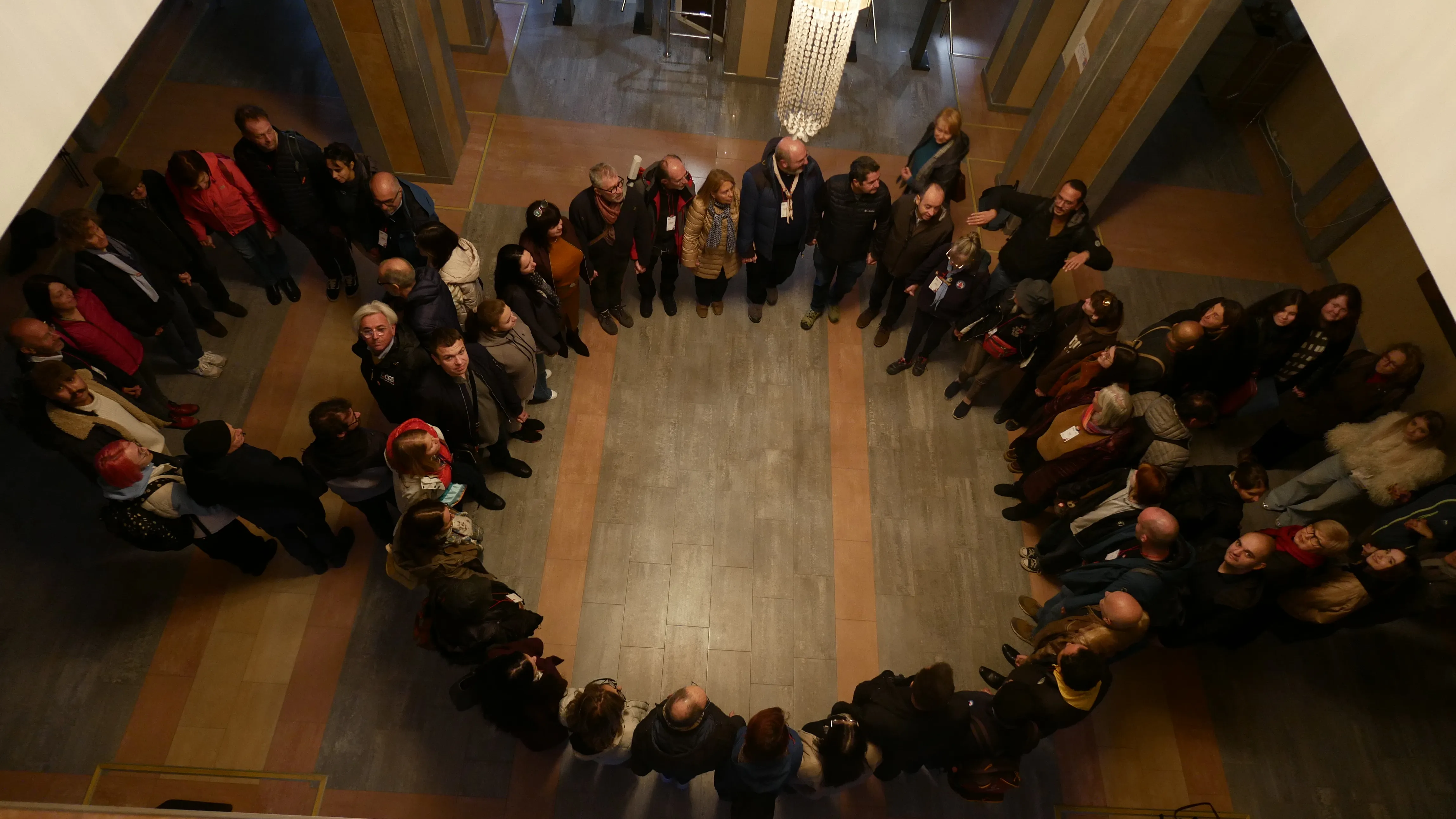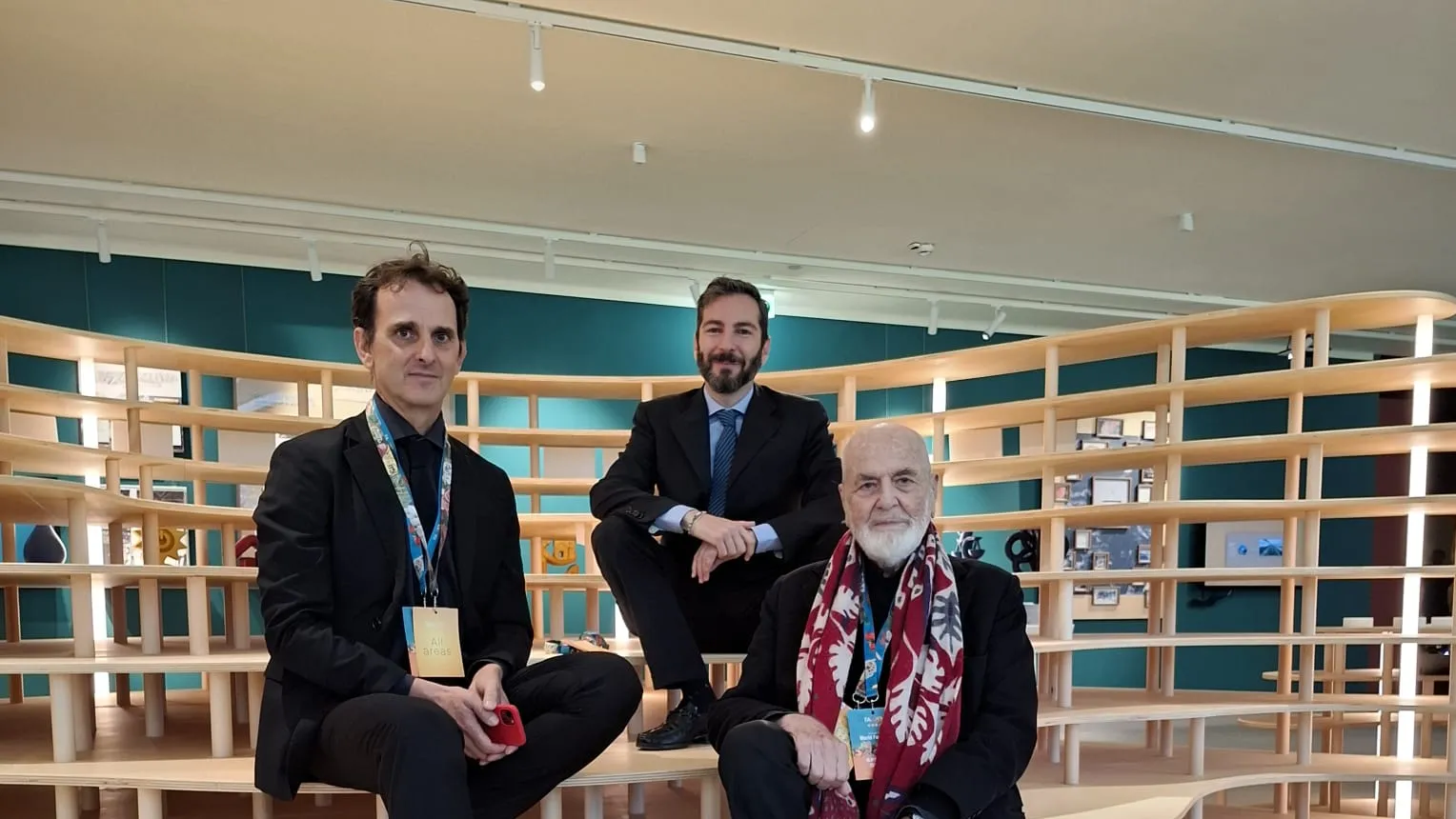What can we
help you find?
Ricerche suggerite

Michelangelo Pistoletto and Cittadellarte bring the Third Paradise to the Pyramids of Giza
Past and future come together in a universal symbol of rebirth: the artist and his Foundation, with a new installation of the trinamical symbol, are among the protagonists of the fifth edition of Forever Is Now by Art D'Égypte by Culturvator curated by Nadine A. Ghaffar, the international exhibition where art meets the eternity of ancient Egypt.
Between sand and sky, the master’s art enters into dialogue with eternity: Cittadellarte and Michelangelo Pistoletto, with an unprecedented installation of the Third Paradise, take part in the new edition of Forever Is Now by Art D'Égypte by Culturvator curated by Nadine A. Ghaffar. The global exhibition of contemporary art, open to the public from 11 November to 6 December 2025, unfolds across the Pyramids of Giza. Specifically, the Pistoletto Foundation will present a collective installation bringing together international artists invited to reinterpret the legacy of the Pyramids of Giza through their contemporary practices. Hosted on the UNESCO site and the surrounding plateau — places with 4,500 years of history — the exhibition does not simply celebrate the past, but weaves it into the present, exploring the symbolic and cultural value of the pyramids as emblems of humanity’s desire for immortality and infinity. The works on display reflect on the dialogue between history and contemporaneity, offering new interpretations of legacy and endurance in one of the most iconic places in the world.
Alongside Michelangelo Pistoletto's installation, the event will welcome a group of nine other prominent international artists, each engaged in reinterpreting the dialogue between past and future through different visual languages. Among them: Alexandre Farto aka Vhils (Portugal), Mert Ege Köse (Turkey), Recycle Group (France and Russia), J-Park (South Korea), Alex Proba & SolidNature, Nadim Karam (Lebanon), Ana Ferrari (Brazil), King Houndekpinkou (West Africa), and Salha El Masry (Egypt).
“Between the sand and the sky of Egypt,” reads the press release, “the language of art becomes a bridge between past and future, renewing in Giza the eternal bond between human creativity and universal memory.”

Photo by Alessandro Lacirasella.


Photo by Alessandro Lacirasella.
The Third Paradise and the Pyramids
The project by Michelangelo Pistoletto and Cittadellarte represents a symbolic encounter between two visions of eternity: the Pyramids, immortal monuments of antiquity, and the Third Paradise, a universal sign of regeneration and harmony between nature and the artificial world.
The symbol is a re-elaboration of the mathematical sign of infinity, enriched with a third central circle representing the fusion and balance between the natural world and the one created by human beings through art, science and technology. Pistoletto describes it as a collective artwork, a symbol of responsibility and rebirth that invites every individual to act for the reconciliation between humanity and the planet.
“In a historical moment marked by uncertainty and transformation,” the organisers explain, “the exhibition draws inspiration from the enigmatic wisdom of Egyptian beliefs, exploring themes of transcendence, hope and faith, rooted in our knowledge of the past and the conviction that there is no future without history. We look at the achievements of past eras to question ourselves, find inspiration, and understand the nature of future generations. The Third Paradise thus becomes a contemporary symbol of immortality, a universal invitation to imagine a new beginning.” At the CIAD Gallery, located in Downtown Cairo, a miniature of the artwork is also on display (pictured below).
From the trinamical symbol to the Accademia Unidee
Born in 2003 as an extension of Pistoletto’s artistic thinking, the Third Paradise is now at the heart of an international network of over 300 Rebirth Ambassadors promoted by Cittadellarte, which for more than twenty-five years has worked to connect art and society in a path of responsible and sustainable transformation.
With this same spirit, the Accademia Unidee was founded in Biella — a school of art and social change — which is now strengthening its dialogue with Egypt through a new collaboration with the Italian Cultural Institute in Cairo.
On the occasion of Forever Is Now, the Unidee Academy, together with the Italian Cultural Institute in Cairo, awarded two scholarships to young Egyptian talents. The winners — Mohamed Ahmed Hassan Shoeb for Contemporary Art and Rawan Emad Omar Elfarouk Mohamed Soliman for Sustainable Fashion — were selected among numerous applicants for their ability to embody the values central to the journey of Michelangelo Pistoletto and Cittadellarte: the role of art as a driver of social change and sustainability as a guiding principle of creativity.
The initiative also strengthens cultural ties between Italy and Egypt and promotes access to high-quality artistic education grounded in creativity, ethics and responsibility.


Photo by Alessandro Lacirasella.

Photo by Alessandro Lacirasella.
The voice of Michelangelo Pistoletto
“The pyramids are the foundation, the origin of all our history,” explains Michelangelo Pistoletto, “a history that runs through ancient Rome and Greece and connects even to the most pressing issues of the present: the human need to look towards the sky, to reach it as a goal, while remaining deeply rooted in the earth. The pyramids represent humanity’s desire for survival in terms of immortality, which then becomes the mirror icon I created. Art thus assumes a dimension that transcends time and is reborn today through the trinamical formula of the Third Paradise, which leads to the third phase of humanity — a phase that draws conclusions from everything that has happened so far in order to begin anew. We have the past on one side, in one of the circles of the trinamical symbol; the future in the opposite circle; and our present condition at the centre, which gathers all the past to transform it into the future and, at the same time, reconnect the future to the past. This is why it is so important to have the trinamical symbol of creation placed right in front of the pyramids today: to reconnect with history and project ourselves into the future.”
The words of Cittadellarte’s director
“The stones of the Pyramids of Giza, of Pistoletto’s work, and of all the monuments of history stand before human events as silent witnesses,” the director of Cittadellarte emphasised. “Time leaves signs on them century after century, like hieroglyphs on an immense skin that humanity traces and leaves behind for future generations. The future is already here, built by our actions.
The stones tell tomorrow the stories of today embedded in their silence: stories of pharaohs and workers, of life in the afterworld and here on earth, of architectures that unite earth and sky and all other oppositions, of artists and seekers of truth, of common people and princes. The sky and the desert, here in Giza, reflect one another, and in the centre of a circle of stones a mirror welcomes every passerby, for an instant, into the embrace of history that devours the universe. Here the great void reveals itself, with no more war, because every people and every person unconditionally find space to live and die together. The monument warns and reveals. Will we understand?”





